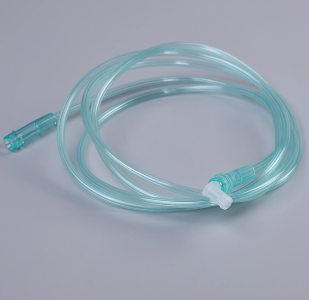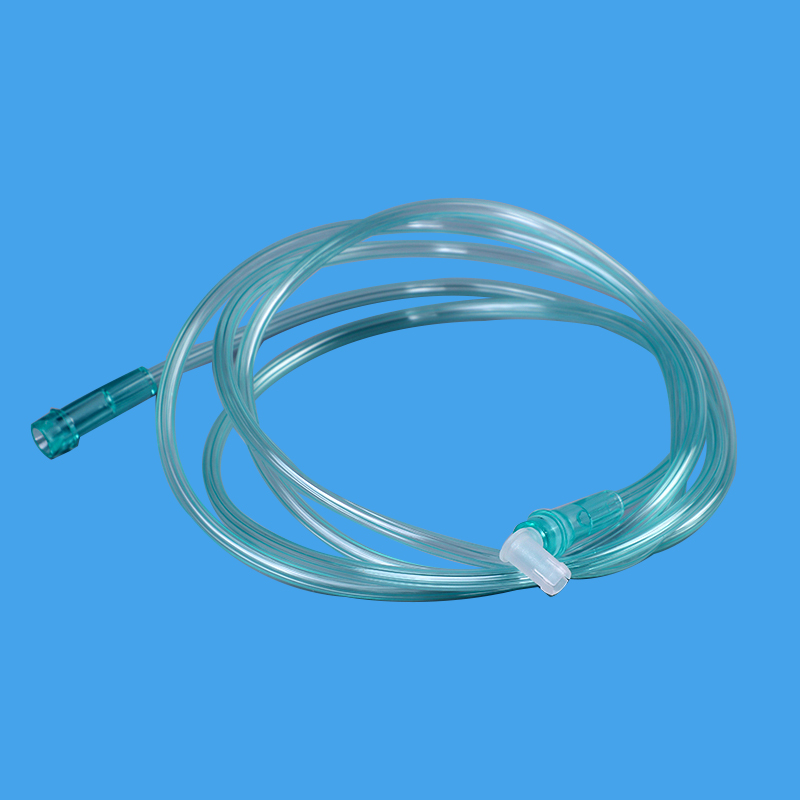-



How To Keep Oxygen Tube in Nose at Night
Views: 0 Author: Site Editor Publish Time: 2025-04-03 Origin: Site

Getting a good night's sleep while using oxygen therapy can be challenging. Many people struggle with keeping their oxygen tube in place at night. In this post, we’ll discuss practical tips to help you keep your oxygen cannula secure and sleep soundly. You’ll learn how to avoid discomfort and improve your oxygen therapy experience during sleep.
Why Keeping the Oxygen Tube in Place at Night is Crucial
What Happens if the Oxygen Tube Moves or Comes Out?
If the oxygen tube moves or comes out while you're asleep, it can have serious effects on your health. The most immediate issue is that your oxygen levels may drop. When the tube isn't delivering oxygen as it should, your body struggles to get the oxygen it needs. This can lead to shortness of breath, increased heart rate, or dizziness.
A lack of oxygen during sleep can also disrupt your rest. When oxygen is insufficient, your body may wake up repeatedly, making it harder to stay asleep. This results in poor-quality sleep, which can leave you feeling tired and weak the next day. Over time, poor sleep can impact overall health, leading to increased fatigue and difficulty concentrating.
How the Right Oxygen Therapy Improves Sleep Quality
The right oxygen therapy at night helps you maintain steady oxygen levels, improving sleep quality. With the correct therapy, you get better oxygen saturation throughout the night, especially during critical REM sleep. REM sleep is when your body recovers the most, but it’s also the phase where oxygen levels can drop significantly for people with respiratory conditions.
By keeping your oxygen levels stable, continuous oxygen therapy ensures you get enough rest. For patients with conditions like COPD, asthma, or pulmonary fibrosis, this is especially important. Proper oxygen therapy helps these patients avoid complications like severe fatigue, breathlessness, or worsening of their condition. With the right setup, sleep becomes restorative, rather than a constant struggle for breath.

Common Challenges People Face While Sleeping with an Oxygen Tube
Discomfort from Nasal Cannulas or Masks
One of the biggest challenges people face is discomfort from the nasal cannulas or masks. The cannulas or masks can cause irritation around the nose, ears, or face. This can lead to redness, sore spots, or even pressure sores if the tubing isn't positioned properly.
Certain sleeping positions make the discomfort worse. For example, sleeping on your side or stomach can push the cannula or mask into your skin, causing additional irritation. The pressure can also affect the flow of oxygen, making it harder to breathe.
Tangled or Caught Oxygen Tubing
Another common problem is tangled or caught oxygen tubing. As you move around during sleep, the tubing can get twisted or pulled, leading to interruptions. This can force you to wake up and reposition the tubing, breaking your rest.
If the tubing gets caught under the bed or between pillows, it can create a choking hazard or stop the oxygen flow entirely. This is especially frustrating for people who toss and turn during the night, causing them to repeatedly adjust the tubing.
Noise from the Oxygen Concentrator
The noise from the oxygen concentrator is another issue that can affect sleep. These machines can be loud, and the hum or buzz might disrupt both the person using the oxygen and their bed partner. This constant noise can make it difficult to fall asleep or stay asleep.
The sound of the concentrator may also make it harder to keep the tube in place. People may find themselves adjusting the tubing or machine to reduce noise, which can further disturb their sleep.
Solutions for Keeping Oxygen Tube in Nose at Night
Finding the Right Fit for Your Oxygen Tube
The first step in ensuring the oxygen tube stays in place is choosing the right cannula. Cannulas come in different materials, like silicone, PVC, or rubber. Each material affects comfort, so it's essential to find one that feels good against your skin. Silicone, for example, is softer and gentler on the nose, while PVC can feel more rigid.
It’s also important to select the right size and prong type. A cannula that’s too large or too small can cause discomfort or even slip out. Make sure the prongs fit comfortably into your nostrils for a secure seal.
If nasal cannulas aren’t the most comfortable option, consider using an oxygen mask. Masks are ideal for those needing higher oxygen flow. While they offer a more secure fit, they may feel more intrusive or harder to sleep with than nasal cannulas. It’s essential to weigh the pros and cons of each option to find the best fit for you.
Securing the Oxygen Tube with Accessories
Using accessories can help secure the oxygen tube while you sleep. Nasal clips, adhesive tapes, and facial straps are popular solutions. Nasal clips hold the prongs securely in place, but they can sometimes be uncomfortable. Adhesive tapes can gently hold the tube in place without causing irritation. However, some tapes may leave residue or irritate the skin, so always check for sensitivity.
For children or sensitive skin, consider using Hy-Tape. This gentle adhesive is often used to secure cannulas, especially for infants. It’s soft and easy to remove, making it a great option for those with delicate skin.
Proper positioning of the cannula or mask is also essential. When you sleep on your back or side, make sure the tubing isn’t pulling or pressing into your skin. Adjust pillows to keep the tube in place and prevent it from shifting out of position.
Preventing Oxygen Tube Displacement
To prevent the oxygen tube from becoming tangled or caught, consider using a tubing management system. These systems help secure the tubing to your bed, clothing, or body, keeping it out of the way during the night. By using clips or Velcro straps, you can reduce the risk of the tubing getting tangled or pulled.
Another helpful solution is adjusting your sleep position. Sleeping on your back or side can help keep the cannula in place. You can also adjust the position of your pillows to prevent the tubing from pulling on the cannula.
If you find that the tubing is too short or restrictive, try using longer tubing. Longer tubing provides more flexibility, allowing you to move freely during sleep without the risk of dislodging the tube.

How to Maintain Your Oxygen Equipment for Better Sleep
Routine Maintenance of the Oxygen Concentrator
Regular maintenance of your oxygen concentrator is crucial for keeping it running smoothly. Clean your machine frequently to reduce dust buildup, which can cause noise or affect performance. Follow the manufacturer’s guidelines for cleaning filters and checking the tubing for blockages. This ensures the concentrator operates efficiently, reducing noise and preventing malfunctions.
Make sure to service the oxygen concentrator as recommended. Regular servicing helps maintain its longevity and efficiency. It’s a good idea to schedule a checkup to ensure everything is working well, especially if you notice any changes in performance or hear unusual sounds.
Replacing Nasal Cannulas and Masks Regularly
Your nasal cannula or mask can wear out over time, affecting the comfort and efficiency of your oxygen therapy. Check your equipment regularly for signs of damage or wear. If the cannula or mask starts to feel uncomfortable or doesn’t fit securely, it’s time to replace it.
Worn-out equipment can cause irritation or lead to oxygen leakage, making it harder to breathe. Most manufacturers recommend replacing nasal cannulas and masks every few weeks, or sooner if they show signs of damage. Regularly replacing these parts ensures you get the best possible oxygen therapy during the night.
Conclusion
Keeping your oxygen tube in place at night is essential for maintaining proper oxygen levels and sleep quality. Use the right equipment, secure the cannula or mask, and make adjustments for comfort. Regular maintenance of your oxygen machine ensures optimal performance. For personalized solutions, feel free to consult Zhenfu Medical to find the products that suit your needs.
FAQs
Q: How can I prevent my oxygen tube from coming out at night?
A: To prevent the tube from coming out, use secure accessories like nasal clips, adhesive tapes, or facial straps to hold the cannula in place.
Q: What is the best way to keep my nasal cannula secure while I sleep?
A: Choose a comfortable, well-fitting nasal cannula and adjust your sleep position to avoid pressure on the tube. Use tubing management systems to reduce tangling.
Q: Can I use a mask instead of a cannula at night?
A: Yes, if you require higher oxygen flow, a mask may be more secure than a cannula, but it may feel less comfortable.
Q: How do I stop my oxygen tubing from tangling while sleeping?
A: Use tubing clips or Velcro straps to secure the tubing to your bed or clothing and prevent tangling during sleep.
Q: What should I do if my oxygen machine is too noisy to sleep?
A: Place the machine in another room or use longer tubing to reduce the noise. You can also use white noise machines or earplugs to mask the sound.
CONTACT US
NO.176, Gaoxin 5th Road, High-tech Industrial Park, Rizhao City276800, Shandong Province, China +86-13396234532 +86-13396234532Copyright © 2023 ZhenFu Group All Rights Reserved. Technology By leadong.com | Sitemap | Privacy Policy



















